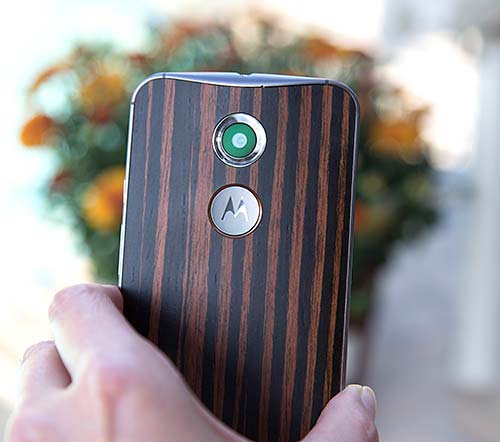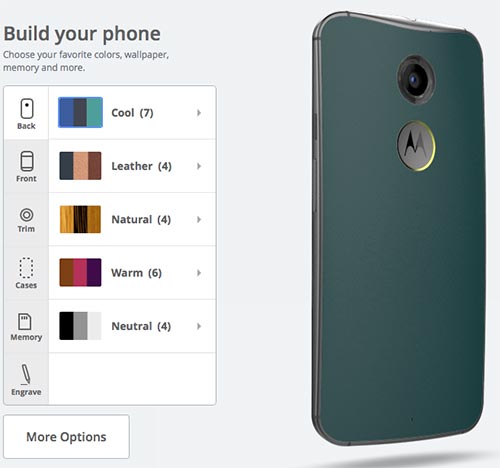Performance and OS
There's little to say here beyond it's all good and the same as other top Android phones. The Moto X runs on the same Qualcomm Snapdragon 801 quad core CPU as competing Android and Windows Phone flagship models. Performance on synthetic benchmarks is a slight bit higher thanks to the clean Android build. Experiential performance is very good--again thanks to the non-skinned UI. After a few release day firmware updates, the phone became one of the most fast and fluid Android phones we've used.
The Moto X has 2 gigs of DDR3L RAM and 16 or 32 gigs of storage. Our 16 gig model has just 10 gigs available, which is a bit light given that you can't expand it with microSD cards. If you're a fan of today's multi-gigabyte 3D games or carrying lots of movies with you, you'll do better with the 32 gig model.
Google's influence on Motorola is clear, and that means phones that are near stand-ins for Nexus and Google Play Edition devices. You get Moto actions and voice, as well as their custom camera app, but beyond that, it's stock Android. That means quicker updates and the phone should be among the first to get Android L, the next major Android release. It also means the phone is quick and has fewer compatibility quirks. Android purists will love the Moto X, but those who enjoy or even prefer heavily skinned Android like that on Samsung Galaxy and LG phones might find it a bit barren and feature-poor. That's up to you.
Benchmarks
| |
Quadrant |
3DMark Ice Storm |
AnTuTu |
Sunspider JavaScript Test (lower is better) |
| Moto X (2nd gen) |
22,170 |
19,924 |
44,340 |
776 |
| Moto X (first gen) |
8357 |
6800 (extreme) |
21,377 |
1097 |
| Motorola Droid Turbo |
22,709 |
20,735 |
48,332 |
795 |
| LG G Stylo |
14,559 |
unsupported phone |
21,542 |
1545(Chrome)/ 1031 (webkit) |
| LG G3 (3 gigs RAM) |
24,385 |
18,708 |
36,525 |
425 |
| Samsung Galaxy S5 |
23,643 |
18,329 |
35,357 |
398 |
| HTC One M8 |
24,527 |
20,896 (unlimited) |
36,087 |
776 |
| Samsung Galaxy Note 4 |
24,327 |
19,667 |
46,912 |
425 |
| Sony Xperia Z1S |
21589 |
16,135 (unlimited) |
35,008 |
837 |
| Nexus 5 |
8808 |
17,828 (unlimited) |
27,017 |
718 |
| Moto G |
8485 |
2778 (extreme) |
17,396 |
1311 |
| Samsung Galaxy Note 3 |
22,006 |
15,092 (unlimited) |
35,823 |
587 |
| LG G2 |
19,762 |
9803 (extreme) |
32,990 |
823 |
| Samsung Galaxy S4 |
12,276 |
11,601 (unlimited) |
24,776 |
826 |
| HTC One M7 |
12,252 |
11,324 (extreme) |
24,589 |
1155 |
| LG Optimus G Pro |
11,994 |
N/A |
18,561 |
867 |
| Samsung Galaxy S III |
5102 |
N/A |
7011 |
1825 |
Geekbench 3: 972 single core, 2951 multi-core
Google Octane 2: 4607
Calling and Data
Motorola has 4 mics on the Moto X--that's a lot and one more than the last gen Moto X. The company excels at call quality and the latest gen Moto X is no exception. Thanks to the 4 mics, outgoing call quality is very good with strong noise reduction that didn't mangle our voice. Incoming calls are also loud and clear. The earpiece (the ornamented slit above the display) is loud and the speaker (the lower slit) is crazy loud for a phone. It's a little louder than the HTC One M8 with BoomSound stereo speakers, but alas the Moto is mono. Happily it still sounds full and rich as phone speakers go, with no shrill hiss or muddy bass.
Data results may vary depending on what version you buy. Verizon sells a variant with CDMA (that's the type of network they use) plus GSM world roaming. AT&T sells the same (according to model number) hardware as the unlocked Pure Edition that Motorola sells direct, and it's a GSM phone with 3G HSPA+ and LTE 4G. There's some confusion on LTE bands supported by the unlocked version (the model we have for review) thanks to Motorola's website. We suspect their website specs were wrong at release based on FCC declarations (these by definition must be accurate) and Motorola's review guide that led us to believe the unlocked model has 4G LTE on bands 2,4,5, 7 and 17. That covers AT&T and T-Mobile and will work overseas on LTE in some countries.
4G LTE Data speeds on the unlocked model were a little below average on AT&T's network in the Dallas area (25Mpbs vs. 35 to 54Mbps), though it did much better than average for upload speeds. We saw average speeds on T-Mobile's LTE network, but in our area those speeds rarely pass 16 Mbps, which says little about the phone's CAT 4 Advanced LTE performance.
Moto Makes the Phone Human
Or human friendly... we've seen Android phones with so many software features of limited practical use that it boggles the mind-- can anyone name all the software features on a Samsung Galaxy phone? I think not. Instead of gimmicks, Moto continues to give us features we actually want and need, much like Apple. Wave your hand over the display and IR sensors on the front tell the phone to show you the informative lock screen with notifications. No need to turn on the phone or even double-tap as with LG and some Nokia Lumia phones. See an email notification on the lock screen? Press and hold its icon to get a preview of the email, or swipe it up to launch the mail program with that message open.
Voice control has gotten even better, and it's a Moto custom solution, not just Google Now voice commands. You don't have to say "OK Google Now", you can say anything you want as the wake phrase, as long as it's at least 4 syllables long (it wouldn't let us use "OK Woody" to wake our ebony wood phone because that's only 3 syllables). Once you train it with your waking phrase (hint, don't use something you say all the time), all you have to do is say it, followed by what you want the phone to do. Leave it sitting on your desk or the center console of your car, sleeping: it's still listening.
Moto actions handle things like quiet time overnight, switching to driving mode where it will do things like read text messages aloud or go into meeting mode (shush) if your calendar has a meeting. For driving mode, you'll need to activate the more accurate GPS location setting.
Camera
What is it with Motorola? Can't they hire a few camera gurus? The last gen Moto X had a 10 megapixel camera that was a sad affair at launch and got a bit better via firmware updates. The second gen Moto X has a 13 megapixel camera with a Sony sensor (likely the same one used in several of last year's flagship phones), so it should be much better, right? Not so fast: Motorola's camera app is a pleasure to use, but the image processing algorithms need work. Focusing is fairly fast, but it sometimes focuses incorrectly (even when using the manual focus and exposure point option, aka tap to focus). Contrast looks like cliche Instagram at times in bright light and both yellows and reds bloom to excess, blotting out detail. If you're a flower photographer, stay away from roses and go for the pink lilies. But even our pink lilies in the shade had overexposed areas that blotched to white or lost detail.
On a good note, the camera is noticeably better than the last gen Moto X, and in good light, the camera can take pleasing landscapes. Low light shots are quite noisy despite the ring flash that surrounds the lens. Not a good phone for clubbing if you want to snap photos to commemorate your outing. 1080p video is quite sharp and colorful, and there's a 4k recording mode too. We like the Moto X better as a video camera than a photo snapper.
Battery Life
Battery life is another sore point, simply because the 2014 Moto X has a 2300 mAh battery while other 5" to 5.5" Android phones have considerably larger batteries. For example, the 5.1" Samsung Galaxy S5 has a 2800 mAh battery and the LG G3 has a 3,000 mAh battery. Even with very good power management, which the Moto X has, you simply can't make a phone with a much smaller battery and the same display and CPU and expect the same battery life. Thus the Moto X typically lasted us from 7am to 8pm with moderate to moderately heavy use. In comparison, the GS5 made it to midnight, as did the HTC One M8.
On a positive note, like other Snapdragon 801 smartphones, the Moto X supports Qualcomm's Quick Charge 2.0, so it charges fast. Even 30 minutes of charging can add 50%. Motorola sells an optional Quick Charge 2.0 charger that can charge even more quickly.
Conclusion
The 2014 Moto X garnered a lot of attention thanks to its somewhat lower price tag, really lovely look and customizable finishes and the clean Android experience. It largely lives up to its reputation as a flagship that can make you proud. I'd say nothing looks as good as the Moto X in Android land, and the vivid (if not over the top) AMOLED display will please many folks. The software enhancements are actually enjoyable and useful, and the phone is fast. The mediocre camera and battery life hold us back from giving the Moto X an Editor's Choice award, but it's still a fine pick.
Price: $499 full retail for base 16 gig model with resin back, $25 additional for wood or leather back, $50 additional for 32 gig model. $99 for 16 gig model with 2 year contract on AT&T or Verizon Wireless.
Website: www.motorola.com
Related Reviews:
Moto X Pure Edition 2015 Review
Motorola Droid Turbo Review
HTC One M9 Review
LG G Stylo Review
LG G4 Review
Moto X 2nd gen vs. LG G3 Comparison Smackdown
Moto G 3rd Gen Review (2015)
Moto E 2nd Gen Review
Samsung Galaxy S6 & Galaxy S6 Edge Review
OnePlus One Review
Moto 360 Review
Sony Xperia Z3 Compact Review
iPhone 6 Review
iPhone 6 Plus Review
Samsung Galaxy Alpha
Nexus 6 Review
Samsung Galaxy Note 4 Review |



|

